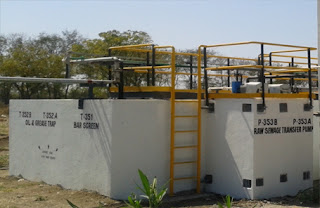Apart from oxygen, the water is invariably the most essential part of human and animal race. Getting pure water to drink is mandatory in our life to remain healthy. Excessive water is used on a daily base for several purposes. The water sources remain at a stagnant level requiring a wastewater plant treatment. The unhealthy water is made drinkable and bacteria-free by the MBBR Sewage treatment plant. It removes harmful chemicals and minerals and turns the dirty into pure water.
Ro Treatment
Umpteen methods are used for water purification. The reverse osmosis plant manufacturer sends the plants for chemical process, humidification, laboratory use, metal finishing, photographic processing and vehicle washing. Many industrial water applications have received positive benefits by the reverse osmosis plant manufacturer. It is also famed as RO filtered water.
The purifiers remove the dust, dirt and anti-microbes from the water, making it safe for the families to drink. The invention of reverse osmosis has decreased the pains of frequent water boiling.
Varied Purifications
For the water purification process: chemical treatment, intake filtering, sedimentation and aeration methods are used. Intake filtering does not make the water potable, but removes the debris and animal carcasses from the water. The method involves the use of diverse sized screens for dirt removal before the water is collected on the plant.
The chemical treatment makes use of chlorine, ozone & iodine to remove microorganisms from water. The MBBR Sewage treatment plant cleans and recycles the wastewater discharge to make it usable for environmental purposes. Wastewater generally comes from industries, houses, business, agriculture, drains and so on. With such a huge amount of water to be cleaned, the reverse osmosis plant manufacturer continues to use innovative techniques to improvise the plant functions and deliver a high quality of water to the people.
Sewage Water Expertise
The MBBR Sewage treatment plant is capable of handling gallons of water in a single day. However, its functions vary in monsoon season. The main motto of the plant is to make the water potable for household purposes. These waters come from irrigation and rivers. It becomes necessary to remove the unwanted minerals and make the water reusable. The BOD destroys the contaminants like bacteria, solid-organic waste and phosphates who are the contributors of pollution.
B-O-D
BOD is biochemical oxygen demanding waste. There are several dead-fish areas found in rivers. This happens because of eutrophication. It lessens the oxygen in river waters resulting in the death of marine creatures. To save those species, the sewage plants are becoming Eco-friendly and rustic proof. Sewage plants can be of two types- the aerobic STP where the oxygen is supplied at a regular pace to the biological reactor. It makes use of impellers driven by pumps. The other one is anaerobic leading to a partial decomposition of sewage in the enclosed reactors. The absence of air leads to the decrease of micro-organisms into methane, CO2 and hydrogen sulphide.
Ro Treatment
Umpteen methods are used for water purification. The reverse osmosis plant manufacturer sends the plants for chemical process, humidification, laboratory use, metal finishing, photographic processing and vehicle washing. Many industrial water applications have received positive benefits by the reverse osmosis plant manufacturer. It is also famed as RO filtered water.
The purifiers remove the dust, dirt and anti-microbes from the water, making it safe for the families to drink. The invention of reverse osmosis has decreased the pains of frequent water boiling.
Varied Purifications
For the water purification process: chemical treatment, intake filtering, sedimentation and aeration methods are used. Intake filtering does not make the water potable, but removes the debris and animal carcasses from the water. The method involves the use of diverse sized screens for dirt removal before the water is collected on the plant.
The chemical treatment makes use of chlorine, ozone & iodine to remove microorganisms from water. The MBBR Sewage treatment plant cleans and recycles the wastewater discharge to make it usable for environmental purposes. Wastewater generally comes from industries, houses, business, agriculture, drains and so on. With such a huge amount of water to be cleaned, the reverse osmosis plant manufacturer continues to use innovative techniques to improvise the plant functions and deliver a high quality of water to the people.
Sewage Water Expertise
The MBBR Sewage treatment plant is capable of handling gallons of water in a single day. However, its functions vary in monsoon season. The main motto of the plant is to make the water potable for household purposes. These waters come from irrigation and rivers. It becomes necessary to remove the unwanted minerals and make the water reusable. The BOD destroys the contaminants like bacteria, solid-organic waste and phosphates who are the contributors of pollution.
B-O-D
BOD is biochemical oxygen demanding waste. There are several dead-fish areas found in rivers. This happens because of eutrophication. It lessens the oxygen in river waters resulting in the death of marine creatures. To save those species, the sewage plants are becoming Eco-friendly and rustic proof. Sewage plants can be of two types- the aerobic STP where the oxygen is supplied at a regular pace to the biological reactor. It makes use of impellers driven by pumps. The other one is anaerobic leading to a partial decomposition of sewage in the enclosed reactors. The absence of air leads to the decrease of micro-organisms into methane, CO2 and hydrogen sulphide.

Nice post, A reverse osmosis plant is a sophisticated water treatment system designed to purify and desalinate water through the process of reverse osmosis. This innovative technology is widely employed in various industries and applications to provide clean, safe, and high-quality water for consumption, industrial processes, and other critical purposes. Here is a comprehensive description of a reverse osmosis plant:
ReplyDelete